Everyone in town knows of the Ormsby House. Even if a good percentage of Carson’s residents moved here after it was closed, they’ve still been eagerly watching the renovation work going on at this hulking hotel at the center of town. But probably few people know where it got its name, or that it is in fact the second Ormsby House to grace Carson Street. So just who was this “Ormsby” anyway?
Major William Ormsby was one of the first residents of the Eagle Valley, back when there was little here besides a trading post. Pictured here is his hotel, the first Ormsby House, in 1863. It was located at the corner of Second and Carson Streets, just a block north of Carson’s other big hotel, the St. Charles. At this point the hotel had been open about three years, and there’s some kind of big event going on; it looks like the whole town turned out to have their picture taken next to the stagecoach. But one person who I know for a fact is not in this photo is William Ormsby himself. Why? Because he was long dead by the time this picture was taken.
Ormsby arrived in the Eagle Valley around 1857-58, the same time that Abe Curry was looking at the valley and deciding that it would be a good place for a town. So when Curry laid out the streets and set aside a “central plaza” for a future state capitol to be built, William Ormsby was one of the first to buy a plot of land from him. He must have shared Curry’s vision that Carson City would one day become the capital of something, because the land that Ormsby chose was right across the street from the plaza. At that time the plaza, and indeed most of the town, was little more than a vast expanse of sagebrush. But William Ormsby took a risk and planned to build a hotel on his land, betting that Carson City would soon become big and all those newcomers and visitors would need someplace to stay. His risk paid off in 1859 when the Comstock Lode was discovered in Virginia City, and miners from all over the country rushed to the area. The Ormsby House opened in early 1860, at the corner of Carson and Second Streets, to immediate success.
Major Ormsby took another risk in May of 1860 when he organized an army of over 100 volunteers to go looking for Paiutes. An outpost east of Dayton had been attacked by Indians, and five white men killed. This news reached Carson City quickly (although the fine details, such as the attack being a retaliation for the white men abducting and raping a couple of young squaws, took a little longer to arrive). This, combined with news of large numbers of Paiutes gathering up by Pyramid Lake, was enough to convince the pioneers that they had an Indian uprising on their hands. So a bunch of concerned citizens got together and rode north to teach the Paiutes a lesson. They didn’t expect much of a fight; they thought they would go out, kill a few Indians, bring home some ponies, and overall have a rather good time. When they got to Pyramid Lake, however, they realized that they had underestimated the Paiutes. In the first battle of what would later be called the Paiute War, the volunteer army was ambushed and slaughtered. Only one quarter of the men made it back to Carson City, Major Ormsby not among them. This risk had proved to be his last.
After Ormsby’s death, the hotel remained a success. In 1864 when Nevada became a state, Carson City became the capital, just as Abe Curry had foreseen. But when it came to naming counties for this new state, it was William Ormsby, not Abe Curry, who was honored. The land where the Major had spent the last few years of his life became known as Ormsby County.
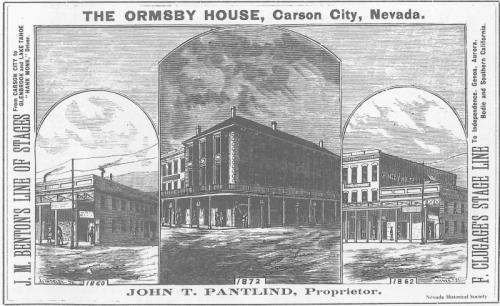
An 1872 ad for the Ormsby House, touting the expansions it had gone through in just 12 short years.
The Ormsby House remained popular throughout the 1800s, but by the end of the century it had been renamed the Park Hotel. During the early 1900s business declined, and when the hotel was bought by the Laxalt family in 1932, it was little more than a flophouse. It was demolished soon after. A real estate office now occupies the site.
The legacy of the Ormsby House didn’t die there, though. In 1972 the Laxalt family resurrected the name for their new hotel, which they built just a few blocks south at Fifth and Carson. At ten stories it was the largest hotel, and tallest building, in town. This is the Ormsby House that everyone knows. But it too only had a couple of good decades before business dropped off. It closed in 2000 for a complete top-to-bottom remodel, and as of this writing, six years later, work is still continuing.
Besides the hotel, a few other things were named for William Ormsby. There is an Ormsby Boulevard in west Carson City, past the middle school. And the Ormsby-Rosser House on Minnesota Street was built for his widow, Margaret, a few years after his death. Ormsby County lasted until 1969, when it was absorbed by Carson City and the county and city governments consolidated. But it’s still the hotel that carries the Ormsby name most prominently, making sure we still remember it nearly 150 years after his death. Even if we don’t remember Ormsby himself.

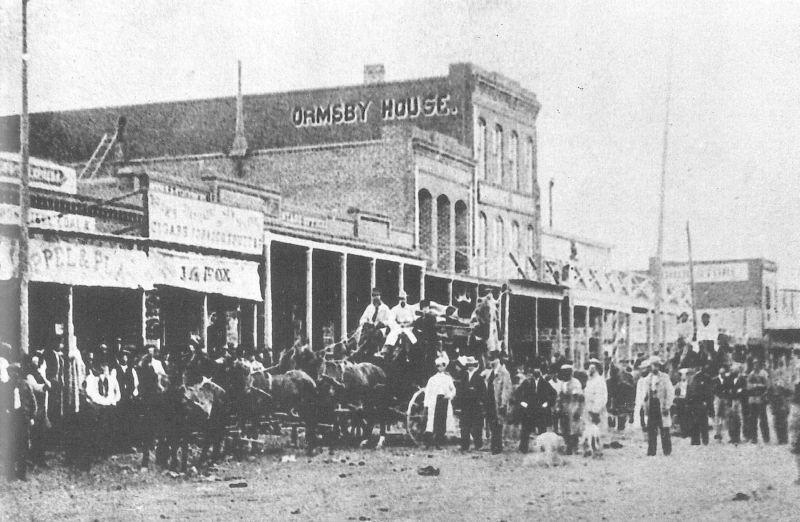
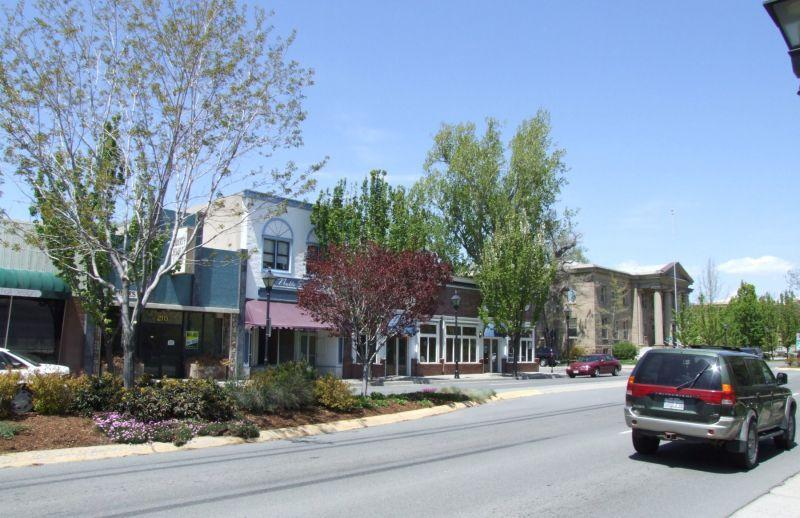
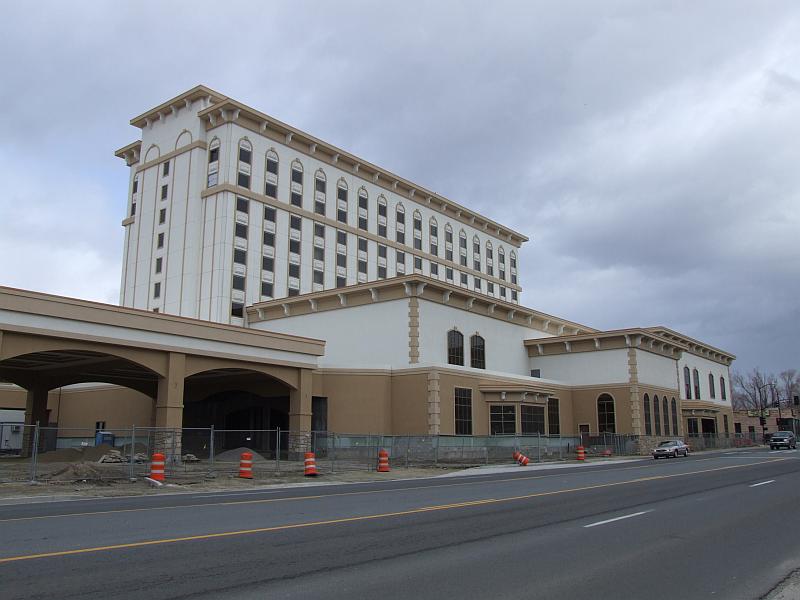



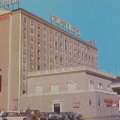
Dear Sirs,
Thank you for such an informative site. However, please be advised that when Col. Ormsby rode with those rebelrousers, he did not, at that time understand that the conflict had been caused by the abduction of tribal minors. When those concerned clan members visited that station, their was no violence intended. It was merely a neighbor asking for help.
I know that your own research shows the same, and further, I understand that you must twist the facts to hide your guilt. But please remember that you can write all the scenarios that you may please, but the truth will always prevail.
If you should judge my assertions to be untruthful, and would like to join me in a public forum to discuss them, then I would be truely honored. For the records sake, I will inform you that this corrospondence will be available to any party whomsoever might request it.
Respectfully,
Tolly
I’m in hope of seeing the Ormsby House in operation in my lifetime.
The site of the original Ormsby Hotel is currently occupied by what I believe to be the original store build by Major William Ormsby – please correct me if this is in error; The Austin Family operated a general store and butcher shop in the building for many years. As both a customer (I resided a block away on Curry) and an employee, I remember the very high ceilings and the length of the building as well as the dentil details on the outside.
As part of a swarm of kids who ambled around Carson during the summer, we often visited the Ormsby graves which were located at the base of C Hill; a couple of neglected ornate marble tombstones in the middle of tall sage, fairly far from the ever-creeping westward edge of town, signified a short and at that time, to us, a heroic life. Now, Ormsby and his foolhardy troupe can be viewed as bit players in the cultural and physical genocide perpetrated upon the Paiute and Washoe nations. Little did we know back then in our naivety that there were no bodies there; Ormsby was originally buried where he fell during the Battle of Pyramid Lake; he was disinterred and reburied in the C Hill grave, and later, he was again disinterred and reburied in New York State. The last time I was in the area, one had to skirt the edge of houses to access the graves.
Regarding Tolly’s comments, rather than be disingenuous and state that there was “no violence intended. It was merely a neighbor asking for help.”, it would be a more honest statement to say that the group of men who went to Williams Station to save their sisters from further rape and violence had every right to execute those who perpetrated those crimes upon these teenage girls by any code of the West operative at a time when law and order were reserved for the wealthy whites of the area. Unfortunately, the incident fed into the general pattern of cultural genocide and violence directed at the indigenous populations of the west.
from http://ormsby.org/genie/Branches/John_S.html
Maj. William M. Ormsby and his brother, Dr. John S. Ormsby departed St Joseph, Missouri, by wagon train on April 14th, 1849. This wagon train consisted of four wagons, six mules to each, and necessary provisions. On May 20, they joined the Newton-Boston Company near Independence, Missouri and arrived in Sacramento in late July, 1849.
Once settled in Sacramento Dr Ormsby and his brother Maj. William M. founded and operated the first private mint in Sacramento, J.S. Ormsby and Company. Note- a $10 gold piece dated 1849 imprinted with the name J.S. Ormsby & Co is valued at over $185,000 in 1999. They also operated an assay office and were the first private gold coiners in Sacramento, the largest trade center near the gold fields. It was located on K Street below the site of the Golden Eagle. They were minting the coins in 1849 and 1850 although none were dated. Early in 1852 Major Ormsby went back to Pennsylvania to bring his and his brother’s families to California, about one hundred souls in the company fitted out with the finest horses and equipment.
from http://historytogo.utah.gov/salt_lake_tribune/in_another_time/082993.html
Major Ormsby–whose rank seems honorary, for he had no record of military service either in the Mexican War or the Indian campaigns–left his ranch in the Russian River Valley of eastern California in 1851 to journey to his Pennsylvania birthplace and guide a number of families back to California. He would have passed through Great Salt Lake City on the eastern leg of that trip before pushing on.
[…] grand landmark will be opened soon. For more on the Ormsby House’s history, see here and here. Tweet(function() { var po = document.createElement('script'); po.type = […]
Tolly stated, “When those concerned clan members visited that station, their was no violence intended. It was merely a neighbor asking for help.” How appropriate he used the word “Clan” [Klan] to describe these good old boys just out to do some friendly “trading” with the Indians…
Major Is my great great grandfather. My Grandma Delmar told me stories of operating the elevator as a child. So fun to see family history.
Megan
I think I met Mr Ormsby one early morning on the 19th floor, I was checking the hallways and halfway down I glanced in one of the tall mirrors, he was standing right behind me, staring, I turned around to ask him if he needed something, he was gone. I wasn’t scared, just puzzled. Out of curiosity I recently looked up the history and the picture of him was exactly who I saw that night. I worked graveyard shift security. Everybody I worked with had stories about things they saw or heard, my boss was a funny guy, when I first started working there he sent me to the old ballroom at 3am, I won’t go into details but I never wet down there again. I’m an old Marine and I don’t scare easily but I could not got out of that place fast enough. Ormsby house might be closed but it ain’t empty.